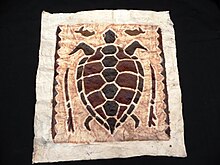Tapa cloth
In Tonga, the same cloth is known as ngatu, and here it is of great social importance to the islanders, often being given as gifts.
Masi could mean the (bark of the) dye-fig (Ficus tinctoria), endemic to Oceania, and probably the one originally used to make tapa.
Somewhere in history, during the voyages of migration the hiapo or siapo was introduced from Southeast Asia, the paper mulberry tree (Broussonetia papyrifera).
It seems likely that before the glueing process became common to make large sheets (see below) only narrow strips were produced.
The major problem with tapa clothing is that the tissue loses its strength when wet and falls apart.
However, it was better than grass-skirts, which usually are either heavier and harder or easily blown apart, but on the low coral atolls where the mulberry does not grow, people had no choice.
In Tonga a family is considered poor, no matter how much money they have, if they do not have any tapa in stock at home to donate at life events like marriages, funerals and so forth.
In New Zealand, presumably early Māori settlers created clothing from the Broussonetia papyrifera (aute) trees that were brought to the islands to be cultivated, however no archaeological evidence of this exists.
[7] By the 1770s, the primary use of tapa cloth was to create a soft, white cloth used for fillets or in ear piercings by high status men, however barkcloth textiles disappeared from use in the early 19th Century, coinciding with the tree's disappearance from New Zealand.
[6] Experimental archaeology on reviving the techniques of this production were pioneered in the 2010s by Māori artist Nikau Hindin, a former student of Hawaiian Studies at the University of Hawaiʻi at Mānoa.
[8][9] The following describes the fabrication of Tapa cloth in Tonga, where it is still part of daily life.
The continuous "thonk" beats of the tapa mallet is a normal sound in Tongan villages.
It then consists of two layers of strips in perpendicular direction, the upper one called lauʻolunga and the lower one laulalo.
A knife or sharp shell, named mutu, is used to trim the edges, and the pieces fallen off in this process are called papanaki.
The bast is then cleaned and macerated in water, after which it is beaten with the ribbed club on a wooden block.
The edges are snipped with shells, and a large number of the pieces are drawn separately over a semi-cylindrical wooden stamp, on which the pattern, worked in coco-fibre, is stretched and smeared with a fluid at once adhesive and colouring.
On both sides there is an unpainted border of about 20 cm (7.9 in) wide, which is called the tapa (in Tonga).
To paint it, the sheets are put over a huge wooden drum covered with stencils or kupesi (upeti in Samoa).
The women will accentuate the faintly visible marks with some more generous paint, this time made from the tongo, the mangrove (Rhizophora mangle).





